
Most gatherings will be in schools, community centers or other public locations, although at least two Republican caucuses will be in private homes and one Democratic caucus will be held at an equestrian center.
Turnout varies by community, with up to 1,000 people typically gathering in cities like Des Moines, while a few dozen or less may gather in more sparsely populated areas
The state Republican and Democratic parties run their caucuses separately, although in some areas they hold them in different parts of the same building. Republicans will have more than 800 caucus sites, and Democrats will have about 1,100.
The two parties also have different rules.
Iowa Democrats gather in groups by candidate preference in a public display of support, a tradition that can allow for shifts back and forth.
If a candidate does not reach the threshold of support of 15 percent of voters in a caucus needed to be considered viable, that candidates' supporters are released to back another contender, leading to another round of persuasion.
US Democratic presidential candidate Bernie Sanders speaks at a campaign rally and concert at the University of Iowa in Iowa City, Iowa.
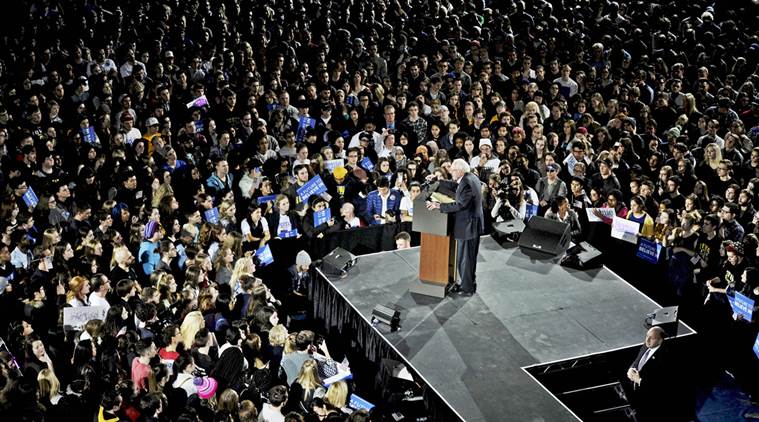
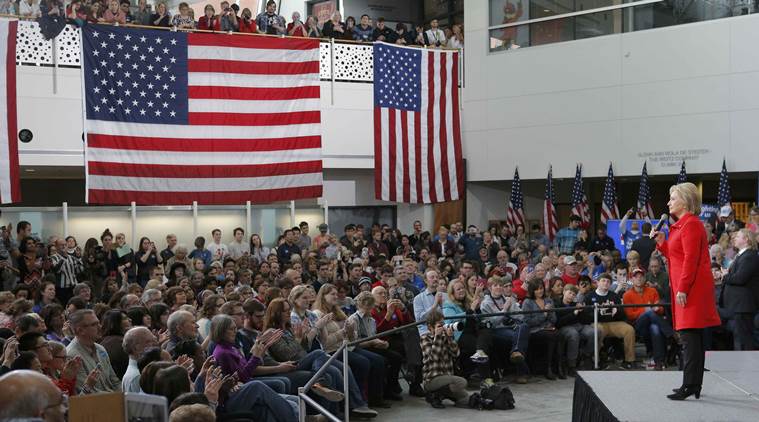
The caucuses
The caucuses are part of a four-stage election of state delegates to send to the national convention of each party.
These delegates then officially nominate their national candidate. The caucuses are held in 10 US states (out of 50) — Iowa, Alaska, Colorado, Hawaii, Kansas, Maine, Minnesota, Nevada, North Dakota and Wyoming.
In the remaining 40 states, primaries, a statewide process in which voters cast secret ballots, are used
The Iowa caucus
The Iowa caucus marks the start of the US presidential race. It’s the first time that voters get to have a say in the electioneering process of their parties. Registered voters will physically assemble in 1,681 precincts, including churches, libraries and other smaller venues, across the state Monday to vote for their candidate
The process
Republicans and Democrats have different processes for their respective caucuses.
Members need to be physically present at their respective precinct for the vote.
Republican Caucus
A standard secret ballot is held at the caucus sites and the total votes are tallied across the state. Once the votes are tallied for each of the precincts, and then each of the counties (99 in the case of Iowa), delegates are selected for the state.
Democratic Caucus
It is a more complicated and “grander” process. Instead of a secret vote, the attendees are supposed to physically assemble with other supporters of their candidate at designated spots. A head-count is then conducted. The atmosphere is almost like a carnival, with voters persuading others to join them. Those candidates who fail to gather 15 per cent of the attendees at the precinct are eliminated, and their voters are told to join the groups of other candidates.
Neither party is offering voter turnout estimates this year, although many Iowans predict the Republicans will surpass the 121,503 who turned out in 2012. In the last contested Democratic caucus, in 2008, excitement over Barack Obama's candidacy spurred a record turnout of 239,872.
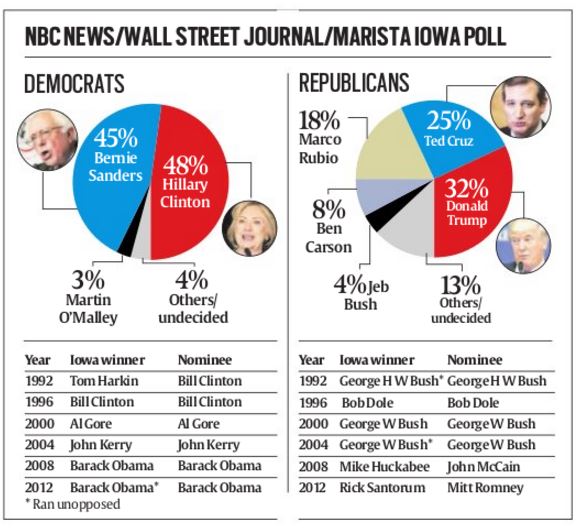

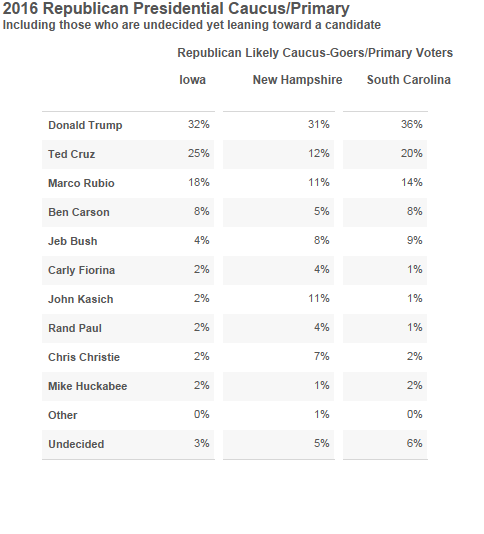
Note
Who can be president?
Technically, to run for president, you only need to be "a natural born" US citizen, at least 35 years old, and have been a resident for 14 yearsIn reality, however, every president since 1933 has been a governor, senator, or five-star military general.
One person is nominated to represent the Republican and Democratic parties in the presidential election
A series of elections are held in every state and overseas territory, starting in February, which determine who becomes each party's official presidential candidate.
The winner of each collects a number of "delegates" - party members with the power to vote for that candidate at the party conventions held in July, where candidates are formally confirmed.
The more state contests a candidate wins, the more delegates will be pledged to support them at the convention
The Republican candidate will need 1,237 delegates to win a majority, while the Democratic contender must secure 2,383.
Each state has a number of electors in the
electoral college proportionate to its population: the sum of its
number of senators (always two) and representatives in the House.
Technically,
Americans on election day cast votes for electors, not the candidates
themselves, although in most cases the electors' names are not on the
ballot.
California, the most populous state, has 55 electoral votes. A few small states and the District of Columbia have only three.
Today,
the electoral college has 538 electors, and in all but two states,
Maine and Nebraska, all of the state's electors are awarded to the
winner of the popular vote within that state.
A candidate needs to win 270 electoral votes - half of the total plus one - to win the White House.
Since 1804, four presidents have been elected who did not win the popular vote.
Most
recently, in 2000 Al Gore won 48.38% of votes nationwide compared to
George Bush's 47.87%. Yet George Bush won because he got 271 electoral votes
compared with 266 for Mr Gore.
What happens if no candidate gets a majority of electoral college votes?
In 1824, four candidates split the electoral vote, denying any one of them a majority.
Democrat Andrew Jackson had the most electoral votes and the greatest share of popular votes and expected to be president.
But
the fourth-place finisher, House Speaker Henry Clay, thought little of
Jackson and persuaded the House to back second-place finisher John
Quincy Adams. Adams was voted in as president.
Both parties hold primaries / caucuses on the same day (unless indicated)
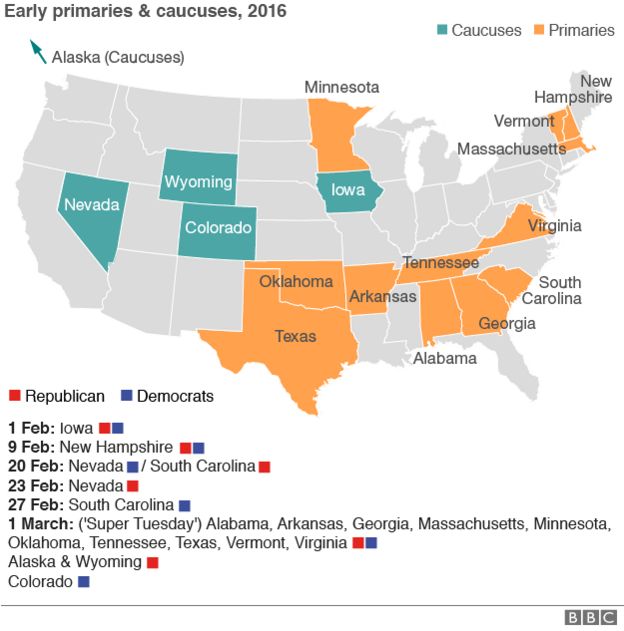
1 Feb: Iowa Caucuses
9 Feb: New Hampshire Primary
20 Feb: Nevada Caucuses (Democratic), South Carolina Primary (Republican)
23 Feb: Nevada Caucuses (Republican)
27 Feb: South Carolina Primary (Democratic)
1 March - 'Super Tuesday': Alabama, Arkansas, Georgia, Massachusetts, Oklahoma, Tennessee, Texas, Vermont, Virginia Primaries; Alaska & Wyoming Caucuses (Republican), Colorado Caucuses (Democratic)
5 March: Kansas Caucuses, Louisiana Primary, Kentucky & Maine Caucuses (Republican), Nebraska Caucuses (Democratic)
6 March: Maine Caucuses (Democratic)
8 March: Hawaii & Idaho Caucuses (Republican), Idaho Primary (Republican), Michigan & Mississippi Primaries
15 March: Florida, Illinois, Missouri, North Carolina, Ohio Primaries
Big states with lots of delegates up for grabs, especially where it's winner takes all. Also swing states where electorates are more moderate so there's potential for an establishment candidate to make a comeback.
22 March: Arizona Primary, Utah Caucuses, Idaho Caucuses (Democratic)
26 March: Alaska, Hawaii, Washington Caucuses (Democratic)
1 April: North Dakota Caucuses (Republican)
5 April: Wisconsin Primary
9 April: Wyoming Caucuses (Democratic)
19 April: New York Primary
26 April: Connecticut, Delaware, Maryland, Pennsylvania, Rhode Island Primaries
3 May: Indiana Primary
10 May: West Virginia Primary, Nebraska Primary (Republican)
17 May: Oregon Primary, Kentucky Primary (Democratic)
24 May: Washington Primary (Republican)
7 June: California, Montana, New Jersey, New Mexico, South Dakota Primaries; North Dakota Caucuses (Democratic)
14 June: District of Columbia Primary (Democratic)
18-21 July: Republican National Convention
25-28 July: Democratic National Convention
The Iowa caucuses kick off the series of elections held in every state and overseas territory which ultimately determine who becomes each party's official presidential candidate.
The winners of each primary or caucus are awarded a number of party "delegates", who pledge to endorse that candidate at the party conventions in July 2016. Whoever has most delegates wins.
The winner of each primary collects a number of 'delegates' - party members with the power to vote for that candidate at the party conventions held in July, where candidates are formally confirmed.
The more state contests a candidate wins, the more delegates will be pledged to support them at the convention
The Republican candidate will need 1,237 delegates to win a majority, while the Democratic contender must secure 2,383
What's the difference between a primary and a caucus?
There are several types of primary with different rules and methods used to win delegates."Open" primaries are open to all registered voters in that state, and they can can vote for any candidate. A Republican voter can vote in the state's Democratic primary, and vice versa for example.
In a "closed" primary, only registered voters affiliated with each party in that state can vote.
In addition, there are also "semi-closed" primaries where voting is closed to registered members of the other party, but open to independents. There are about a half-dozen states that do this, including key early voting New Hampshire.
Caucuses are a series of meetings in which voters show their support for candidates with an open show of hands. Usually only registered voters, affiliated with that specific party, can take part.

No comments:
Post a Comment